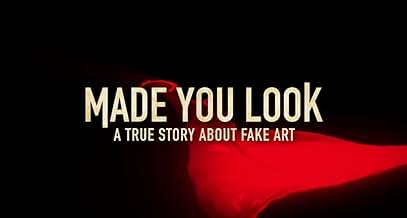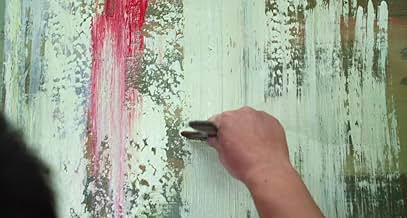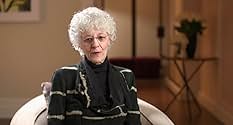Histoire de faussaires: Un chef-d'oeuvre d'arnaque
Titre original : Made You Look: A True Story About Fake Art
- 2020
- 1h 34min
NOTE IMDb
7,0/10
5,1 k
MA NOTE
Documentaire sur la plus grande fraude artistique de l'histoire des États-Unis se déroulant dans le monde de l'art de New York.Documentaire sur la plus grande fraude artistique de l'histoire des États-Unis se déroulant dans le monde de l'art de New York.Documentaire sur la plus grande fraude artistique de l'histoire des États-Unis se déroulant dans le monde de l'art de New York.
- Réalisation
- Scénario
- Casting principal
Patricia Cohen
- Self - The New York Times
- (as Patty Cohen)
Jeffrey Taylor
- Self - New York Art Forensics
- (as Dr. Jeffrey Taylor)
Glafira Rosales
- Self - Art Dealer
- (images d'archives)
Jaime Andrade
- Self - Former Knoedler Gallery Employee
- (images d'archives)
Avis à la une
Intending to profit from fakes and forgeries by convincing a buyer literally to buy into a fake work is a crime. Knowingly creating fakes and frauds in order to profit monetarily from them is also a crime. A "fake" (such as a painting) is a counterfeit item which is purported to be of a certain origin when it is not and the intention behind the item is to decieve. Ann Freedman, former president of the now defunct Knoedler Gallery, didn't create the paintings she sold for approximately $80 million. She didn't even find them in some run-down old house in Mexico or Upstate New York. The paintings were brought to her by a businesswoman, Glafira Rosales, who pretended she was acting on behalf of an anonymous family of collectors. However, all the paintings brought to her by Rosales were fakes.
Freedman claims she was duped like everyone else. Or was she? That's the main question this documentary attempts to answer, or at least, offers the viewer all sides of the story, from art scholars and authenticators to other art dealers to moneyed collectors. No question Freedman is interviewed the most extensively for this documentary, and becomes the main focus of the story as much as the paintings. Interestingly, the documentary cuts back and forth between interviews showing moments where the interviewee's stories don't jive. In several interesting moments, Freedman would claim that one art expert authenticated a work and the expert would assert they never claimed the painting in question was real. In other words, most of the interviewees deny true culpability.
The abstract art style in the US began in the 1930's and picked up steam as a viable artistic movement in the 1940's, after the Second World War, and included such renowned artists as Jackson Pollock, Mark Rothko, Willem de Kooning, and Robert Motherwell. Even Jackson Pollack, dismissed during most of his lifetime, was regarded as a genius shortly before his death in a car accident in 1956. The movement lost its allure and abruptly ended circa 1960 with the rise of pop art by Andy Warhol and similar artists. About 30 years after the movement was more or less over and most of the original artists had died, a resurgence of interest in American Abstract Art among collectors began significantly to augment. Original works by these painters began to sell for millions and in some cases $10 million's. Elite moneyed individuals whose incomes were in the eight, nine, and ten figures per year competed for original works, and the market continues to thrive. To offer a perspective, landscape by Willem de Kooning sold for $300 million in 2015.
From 1994 to 2009 (about 15 years), Freedman sold paintings from an almost unbelievable art well: a collection of paintings by these same American abstract artists from an anonymous source. The original buyer was originally born in Europe (possibly Spain) and supposedly lived in New York for a time, or so went the narrative. He bought the paintings through dealers who had connections to the actual artists, such as Motherwell and Pollock, mostly during the mid-to-late 1950's at the height of the movement. He then relocated his family to Mexico circa 1960.
After the original buyer's passing, the sons and daughters decided they didn't care for the paintings and were willing to sell them into the art market through Rosales at largely discounted/wholesale prices. Rosales claimed the family was so filthy rich they really didn't care that much about the money they'd receive from the paintings. As one art connoisseur explained, rich people are fanatical about money. Paintings by Rothko and Pollack were bought for around $750,000 and resold for $5 million to $8.5 million. Several art experts pointed out that these prices, both at the wholesale level and the selling level were incredibly out of proportion. Most of these works should have been sold for much more, and typically an art gallery is lucky to get about 30 to 40%. Mark-up's of nearly 10 times the wholesale price is almost unheard of. And this is one of the main arguments why some people in the art world believe Freedman was a knowingly culpable participant.
Everything was peachy for Freedman and the Knoedler Art Gallery until several authentications of paintings were returned because of dubious results. Paint and pigments which either didn't exist or were never used by the artists were showing up in these paintings. There were even misspellings of the artists' supposed signatures. However, Freedman stuck by her paintings, believing literally until the 11th hour they were real. As Maria Konnikova, author of "The Confidence Game", points out, victims of con games tend to double down on their beliefs in the canard even when presented with all the evidence. Not until irrefutable evidence reared its ugly head that Freedman had to admit something was amiss. A mistake worth $80 million! An enjoyable documentary about one of the most troubling cases in art fraud history.
(As far as I know, if someone created a fake Jackson Pollack, hung it up on their wall, and claimed it was a Pollock to impress their friends but didn't sell the piece for money, he or she would not have committed a crime because there is no victim. Although if the paintings were ever proved to be fakes or copies, that person might lose not only a lot of credibility but a lot of friends. "Clark Rockefeller" was a human fake because he was not a Rockefeller but really a German provincial. He showed off fakes and copies of modern masters in New York to perpetuate his false narrative regarding his pedigree.)
Freedman claims she was duped like everyone else. Or was she? That's the main question this documentary attempts to answer, or at least, offers the viewer all sides of the story, from art scholars and authenticators to other art dealers to moneyed collectors. No question Freedman is interviewed the most extensively for this documentary, and becomes the main focus of the story as much as the paintings. Interestingly, the documentary cuts back and forth between interviews showing moments where the interviewee's stories don't jive. In several interesting moments, Freedman would claim that one art expert authenticated a work and the expert would assert they never claimed the painting in question was real. In other words, most of the interviewees deny true culpability.
The abstract art style in the US began in the 1930's and picked up steam as a viable artistic movement in the 1940's, after the Second World War, and included such renowned artists as Jackson Pollock, Mark Rothko, Willem de Kooning, and Robert Motherwell. Even Jackson Pollack, dismissed during most of his lifetime, was regarded as a genius shortly before his death in a car accident in 1956. The movement lost its allure and abruptly ended circa 1960 with the rise of pop art by Andy Warhol and similar artists. About 30 years after the movement was more or less over and most of the original artists had died, a resurgence of interest in American Abstract Art among collectors began significantly to augment. Original works by these painters began to sell for millions and in some cases $10 million's. Elite moneyed individuals whose incomes were in the eight, nine, and ten figures per year competed for original works, and the market continues to thrive. To offer a perspective, landscape by Willem de Kooning sold for $300 million in 2015.
From 1994 to 2009 (about 15 years), Freedman sold paintings from an almost unbelievable art well: a collection of paintings by these same American abstract artists from an anonymous source. The original buyer was originally born in Europe (possibly Spain) and supposedly lived in New York for a time, or so went the narrative. He bought the paintings through dealers who had connections to the actual artists, such as Motherwell and Pollock, mostly during the mid-to-late 1950's at the height of the movement. He then relocated his family to Mexico circa 1960.
After the original buyer's passing, the sons and daughters decided they didn't care for the paintings and were willing to sell them into the art market through Rosales at largely discounted/wholesale prices. Rosales claimed the family was so filthy rich they really didn't care that much about the money they'd receive from the paintings. As one art connoisseur explained, rich people are fanatical about money. Paintings by Rothko and Pollack were bought for around $750,000 and resold for $5 million to $8.5 million. Several art experts pointed out that these prices, both at the wholesale level and the selling level were incredibly out of proportion. Most of these works should have been sold for much more, and typically an art gallery is lucky to get about 30 to 40%. Mark-up's of nearly 10 times the wholesale price is almost unheard of. And this is one of the main arguments why some people in the art world believe Freedman was a knowingly culpable participant.
Everything was peachy for Freedman and the Knoedler Art Gallery until several authentications of paintings were returned because of dubious results. Paint and pigments which either didn't exist or were never used by the artists were showing up in these paintings. There were even misspellings of the artists' supposed signatures. However, Freedman stuck by her paintings, believing literally until the 11th hour they were real. As Maria Konnikova, author of "The Confidence Game", points out, victims of con games tend to double down on their beliefs in the canard even when presented with all the evidence. Not until irrefutable evidence reared its ugly head that Freedman had to admit something was amiss. A mistake worth $80 million! An enjoyable documentary about one of the most troubling cases in art fraud history.
(As far as I know, if someone created a fake Jackson Pollack, hung it up on their wall, and claimed it was a Pollock to impress their friends but didn't sell the piece for money, he or she would not have committed a crime because there is no victim. Although if the paintings were ever proved to be fakes or copies, that person might lose not only a lot of credibility but a lot of friends. "Clark Rockefeller" was a human fake because he was not a Rockefeller but really a German provincial. He showed off fakes and copies of modern masters in New York to perpetuate his false narrative regarding his pedigree.)
A very well presented documentary and a scathing indictment of abstract expressionist art, in that it can be so easily forged and accepted as original art by every top, bona fide art expert. Well not ALL the experts. The forensic scientists that were called upon to test the paintings, proved beyond all doubt that these were100% forgeries.
The eminently guilty gallery director, Ann Freeman, had a one of the fake Jackson Pollock's hanging on her wall for ten years....WITH HIS SIGNATURE'S NAME MIS-SPELLED! That's right! Pollock mis-spelled his own name when he signed the front of his painting. I think that's a big red flag, huh?
What was so startling in this doc was, much like Bernie Madoff and his greedy clients, there was enough blatant, drooling avarice on the part of gallery owner, the gallery director, the painting's seller AND the painting's buyers, that I think they ALL got what they deserved....sort of.
Disheartening at best, as the rich never really lose, never feel remorse and everyone pretty much gets back to business as usual.
The eminently guilty gallery director, Ann Freeman, had a one of the fake Jackson Pollock's hanging on her wall for ten years....WITH HIS SIGNATURE'S NAME MIS-SPELLED! That's right! Pollock mis-spelled his own name when he signed the front of his painting. I think that's a big red flag, huh?
What was so startling in this doc was, much like Bernie Madoff and his greedy clients, there was enough blatant, drooling avarice on the part of gallery owner, the gallery director, the painting's seller AND the painting's buyers, that I think they ALL got what they deserved....sort of.
Disheartening at best, as the rich never really lose, never feel remorse and everyone pretty much gets back to business as usual.
A documentary that show that the art critics and experts are the same as wine experts when you ask them to asses a wine blindfolded.
Sad to see that the "cultivated" people don't buy art because they make them feel something but because it's a Kooning (or other famous name) presumably.
Not to say Ann Freedman is not guilty, but she had a lot of support to think the paintings were real. Honestly, seems like there were a lot more reinforcing that the paintings were authentic than there were those that questioned it. I felt the De Sole's were more just pissed about wounded pride than seeing that maybe it was a mistake. No forgiveness for being human from them. And you can believe something, and then as evidence presents itself, realize you were wrong. Isn't that the way the brain is supposed to work? Regardless, who cares about rich people being ripped off - welcome to the club, jerks. At least you still have a roof over your head and food in the table.
I have to admit, I was not eve aware of this story. And the story is real ... unlike the art on display here. Which is fake - and either apparently fake or not so much. Now are we gullible and believe one side or are we with those who were confident from the start? Not an easy question to answer for sure.
The really good thing here is that you get both sides (or even more) and can make your own ... picture! Just be sure not to pretend your own picture isn't a classical painting by someone else ... wait does that make sense? Maybe not, but it sounded funny. And while the subject matter is quite serious I personally found quite a lot of comedy in this too. What's your verdict then?
The really good thing here is that you get both sides (or even more) and can make your own ... picture! Just be sure not to pretend your own picture isn't a classical painting by someone else ... wait does that make sense? Maybe not, but it sounded funny. And while the subject matter is quite serious I personally found quite a lot of comedy in this too. What's your verdict then?
Le saviez-vous
- AnecdotesMichael Armand Hammer is the father of the actor Armie Hammer
Meilleurs choix
Connectez-vous pour évaluer et suivre la liste de favoris afin de recevoir des recommandations personnalisées
- How long is Made You Look: A True Story About Fake Art?Alimenté par Alexa
Détails
- Date de sortie
- Pays d’origine
- Site officiel
- Langues
- Aussi connu sous le nom de
- Made You Look: A True Story About Fake Art
- Société de production
- Voir plus de crédits d'entreprise sur IMDbPro
- Durée1 heure 34 minutes
- Couleur
Contribuer à cette page
Suggérer une modification ou ajouter du contenu manquant

Lacune principale
What is the Spanish language plot outline for Histoire de faussaires: Un chef-d'oeuvre d'arnaque (2020)?
Répondre



































